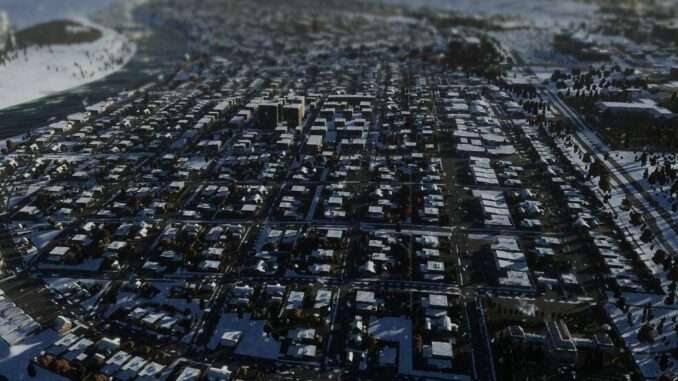
A conprehensive guide on the electric power plants available in the base game Cities Skylines II.
Contents
Preface
All credit goes to Ben!
Allright, le me preface this by saying I don’t play Cities Skylines to “win the game”. For me it’s just a canvas where I can do what I enjoy or what feels fulfilling.
So I totally get that you don’t place an asset or a service because you have to but also because it feels like that’s the right thing to plop in that space. It creates an atmosphere and we don’t care if it should or shouldn’t be there, or is not the most optimized way to do things.
We just have a vision and yours might be a hell made of black smokes, one running on renewables only, or a city that’s massively subsidised and doesn’t give a flying crap about what’s financially wise.
But sometimes, you gotta do what’s best, and with the massive shift that Cities Skylines II is compared to its predecessor, I think a lot of people just have outdated beliefs. And some of us like to play through the milestone and optimise, at least at the beginning.
Oh and I tried to consider realistic scenarios, but I have been playing the game for only about 50 hours or so, so I might be missing some insights. Nevertheless this guide will allow you to run your own numbers and see for yourslelf.
All tests made under 1.0.12 f1 build

For my calcs, I’ve assumed water costs of around 0.295 per cubic metre, since that seem to be the lowest rate you can get ingame with the Advanced Pump Station and Wastewater treatment plant.
Garbage wasn’t considered because I’m not entirely sure how “garbage accumulation” works. If I figure it out at some point I’ll include it in the calculations. But it’s unlikely to move any of my conclusion because there isn’t a huge variation. Most plants are between .7 to 1 garbage accumulation per MW and the outlier are so bad without even considering this that it will just make them even worse.
Of course the different types of pollution, the size or the workforce needs can’t be analyzed from a mathematics standpoint, but those factors will play a role depending on the shape of your build. So don’t overlook them.
Green means it’s cheaper than importing. Red is fairly more expensive. Orange is close enough that you could consider it a tie

Starting a City: Electricity on a Budget
There is no shame in Importing electricity

When you start your city, one of the easiest way to get going is to place a transformer station and import whatever electricity you need. This allows you to spare your very hard earned cash for the time being. However, each MW costs 5k/month to import, not counting the cost of the transformer station. The power plants you can build yourself range from 1.6 to 3.7k/month per MW, so quite a bit cheaper. Also keep In mind exporting yields 2.5k/month per MW, meaning some power plants could actually turn you a profit even if you don’t need all the power they can offer.
Lastly, please consider the capital you need to build your own powerplant, the space required on the map (most are very large buildings), the need for the appropriate education level among your citizens and the pollution it can generate.
Wind Turbine

- Footprint: 3×3 cells
- Workforce: none
- Upfront cost (base / upgraded): 25K / 65K
- Maximum output (base / upgraded): 5 MW / 8.5 MW
- Upkeep w/o water (base / upgraded): 15K / 23K
- Ground / Air / Noise pollution: – / – / 20000
If you can’t maintain 60% efficiency (ie 3MW when you place it down) don’t even bother as it will be cheaper to just import whatever you need. Can be a great option on some maps though thanks to its small footprint and no workforce nor road access required.
First (and arguably only) upgrade to get is the rotor. You can pick the solar panels too, but they don’t lower the overall upkeep, they cost a pretty penny, and they won’t provide much power. Assuming you were to place 8x wind turbines upgraded with the rotors, it will net you the same power output (60 MW) for 160 000/month upkeep and an upfront cost of 320 000$. If you build the solar panels on top, you’d need only 7 of those turbines (so 1 less) to generate the same power (59.5 MW) at the same upkeep cost (161 000/month) but the upfront cost would be 42% higher (455 000$).
Small Coal Power Plant

- Footprint: 14×16
- Workforce: educated (20%/2)
- Upfront cost: 100K
- Maximum output: 20 MW
- Upkeep w/o water: 70K
- Ground / Air / Noise pollution: 30000 / 30000 / 30000
The worst option in the game by far. Sure, it’s a reliable 3500$/MW/month, but it won’t get you very far. Within a few months you’ll be done with it and should be able to replace it for a bigger/cleaner one, meaning it will have cost you around 5000$/MW (over 4 months) so roughly the same than importing. It also pollutes quite a bit considering its small output and generates its fair share of garbage. I can only see this being an option for maps without an outside electric connection or to roleplay a developing country.
Getting Serious: Your First “Real” Power Plant
Depending on your playstyle, this might be the first power plant you invest in, the earlier options being so lame. All 3 are big and reliable power plants, the difference lies in the details.
Gas Power Plant

- Footprint: 27×38 cells
- Workforce: Well educated (25%/7)
- Upfront cost (base / upgraded): 650K / 1100 K
- Maximum output (base / upgraded): 250 MW / 350 MW
- Upkeep w/o water (base / upgraded): 625K / 1111K
- Ground / Air / Noise pollution: 10000 / 10000 (5000) / 10000
Cheapest to build, but most expensive to run out of the 3 “Tier 2”. It’s also the least polluting and its air pollution can be further reduced with the upgraded filters. From a financial standpoint, the consumption or turbine upgrades do not make sense, either taken on their own or added together. It will always net you a worse upkeep per MW.
Coal Power Plant

- Footprint: 50×39 cells
- Workforce: Well educated (25%/8)
- Upfront cost (base / upgraded): 1000K / 1750K
- Maximum output (base / upgraded): 300 MW / 400 MW
- Upkeep w/o water (base / upgraded): 600K / 820K
- Ground / Air / Noise pollution: 100000 / 100000 (50 000) / 100000
It’s big, dirty, but powerful. Best output out of the 3 “Tier 2” plants. Although it should be said the only upgrade that increases its output is not really worth it (high cost to build and maintain) so it should only be done for space reasons. But if you stay at 300 MW, there’s no real incentive to go the coal way as the other plants can achieve the same output with much less downsides.
The upgrade for its resource consumption is barely worth it since it will allow you to save 7500/month on the base plant (so you’ll need almost 3 years to make your money back). It’s slightly better with the 2nd turbine but still yields a worst cost/month per MW than the base plant and that furnace will still require 9 months to get your money back. That being said, this is purely theorical as right now, they don’t seem to work: the amount of fuel you burn remains the same with or without the upgrade.
Note: In both Gas and Coal instances I have used import prices (or so it seems). It’s unclear (to me at least) how the production of said fuels in your city would affect the runnning costs of the power plants. However, it is likely that those materials would be further transformed in your city if they weren’t used to power it up, and so the deficit would probably be the same or even greater.
Geothermal

- Footprint: 44×35 cells
- Workforce: Well educated (23%/5)
- Upfront cost (base / upgraded): 750K / 1375K
- Maximum output (base / upgraded): 150 MW / 300 MW
- Upkeep w/o water (base / upgraded): 300K / 575K
- Ground / Air / Noise pollution: 15000 / 15000 / 15000
Although the game UI states the Geothermal plant is “somewhat” expensive to maintain, it’s actually the cheapest of the “Tier 2” power plants, and second only to the NPP overall. The Coal power plant is not too far behind but is still more expensive, pollutes way more, and require resources (so there’s a risk of shutdown). The only real drawback in my eyes is the lack of freedom of placement, since you need groundwater deposits. But these seems pretty common on the vanilla maps so far. It might not be realistic though and I could see custom maps where such ground deposits are few and far between (and possibly being your only access to clean water) in which case the geothermal might not be as good.
The Last Stage: No More Air Nor Ground Pollution
Nuclear Power Plant

- Footprint: 72×41 cells
- Workforce: Highly Educated (25%/33)
- Upfront cost: 5000K
- Maximum output: 750 MW
- Upkeep w/o water: 1000K
- Ground / Air / Noise pollution: – / – / 150000
On paper, the Nuclear Power Plant (NPP) is the better option even if it costs a fortune upfront, is ginormous and requires a considerable workforce. Usually its upkeep is what tilts the scale. However, 750 000 m3 of water is nothing to sniff at. In fact, assuming the most favorable rates, it will cost you around 300k/month to provide clean water and sewage for your NPP. While the water upkeep for most plants is around 2-3% of their total upkeep, it raises to 18% on the NPP !
That being said, the NPP still is the best option overall and should be the most profitable option after around 8 to 15 months (time needed to offset the huge upfront cost). But you’ll need to pay attention to that water cost because I’ve used the cheapest price per m3 (sewage outlet + advanced pumping station). If you run less ideals plants it will cost you even more and possibly offset the gains of the NPP.
Solar Power Plant
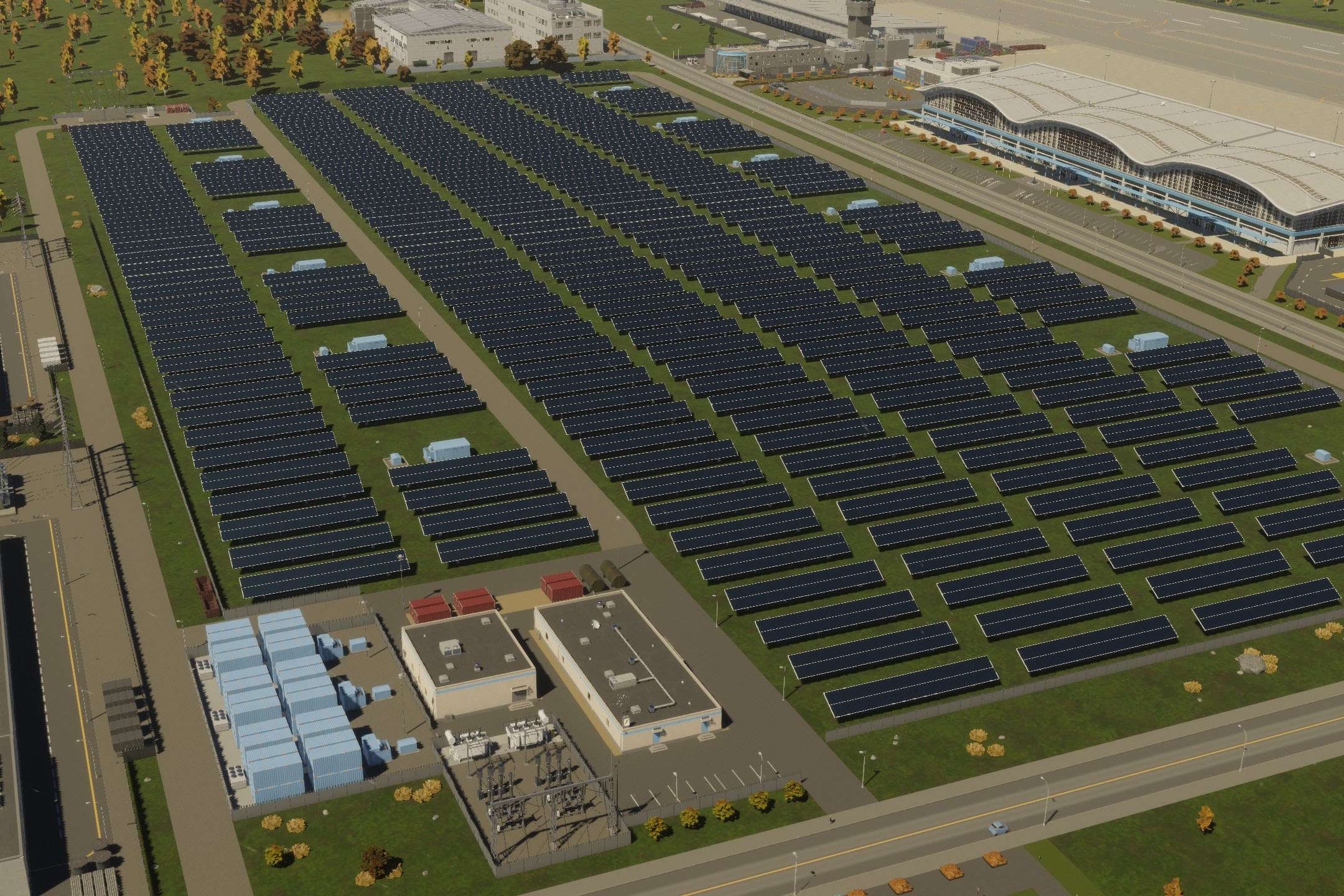
- Footprint: 36×70 cells
- Workforce: Well educated (25%/4)
- Upfront cost (base / upgraded): 1500K / 2100K
- Maximum output (base / upgraded): 100 MW / 150 MW (values halved to account for the solar uptime)
- Upkeep w/o water (base / upgraded): 300K / 450K
- Ground / Air / Noise pollution: – / – / 36000
So what about the Solar Power Plant (SPP) you ask ? Well I don’t have accurate enough data on the sunlight and the solar panel output because CO seems to have implemented a fairly initricate system depending on the hemisphere, time of day and the latitude of the map. It’s not even as simple as having 100% efficiency or 0% depending if it’s day or night. Sometimes you’ll be at 80% during the day, probably because of clouds or the sun’s position on the horizon or in relation with the surroundings, which is very realistic indeed. For this reason nobody can tell how much power your SPP is going to produce. However, we can easily assume around a 50% sun uptime as a best case scenario.
First of all, this means you need to cut in half any power output rating the game gives you. So the big SPP would give you 200 MW during daytime, and 0MW during nighttime, which equates to roughly 100MW on average over several months (I can only assume winter and summer hit differently on the efficiency).
Secondly, you’ll need a way to fulfill your electricity needs during this downtime unless you want to resort to importing. Enter the batteries. The SPP itself has an integrated battery of 50MWh and 15 MW output. Notice the lame output. 50 MWh at 15 MW means around 3.3 hours of power. After which your city will run dark. You can upgrade this further with an added backup battery rated at 50 MWh and 50 MW. Or you can make use of the standalone emergency battery station (EBS for short) rated at 500 MWh and 200 MW. While it’s quite a bit bigger, it can be placed anywhere and is much cheaper than the SPP upgrade. If you’re going for capacity, you’ll need 10 upgraded batteries from the plant, for a whopping 420 000/month in upkeep whereas the standalone version will sent you back only 50 000/month. If output is your main goal then you’ll require 4 upgraded batteries and the upkeep would still be 3.3 times higher (168 000/month vs 50 000/month). Even the upfront cost doesn’t make much sense. It would be 3x and 1.2x more expensive respectively.

The only time I could see the upgraded battery be of any use is when you don’t have huge electricity needs and so the standalone EBS would be oversized compared to your only SPP. But even then, considering you can’t turn off / bulldoze upgrades, I’d rather avoid this. Also having a much bigger battery capacity than needed is always preferable to account for lack of sun in winter and allow some leftover power to recharge the battery during daytime.
Let’s make some assumptions. I’d say you won’t unlock or use the SPP until you need 150 MW or more. So let’s say you build 2 of those (rating of 300 MW, effective power generation of 150 MW) and have an EBS alongside those. The upfront cost is 3.15 millions and the upkeep ticks in at 650 000/month. For 150 MW as I said. That makes it 4333/month/MW, barely cheaper than importing.
However you’re fully independent, don’t rely on raw ressources, don’t pollute the ground or the air and you can split your power plants and batteries so your grid doesn’t show any bottleneck. Scaled up on a big city and scattered around the map, this could offer a good protection against natural disasters too.
What About The Damn Dam?
The dam is obviously excluded here because there are an infinite number of dams and so it’s very hard to analyze. But most likely it would be the best solution overall. Its upkeep seems to remain at 100 000 / month no matter its size, the latter only influencing the building cost. So as long as you’re able to make 60 MW out of your dam it’s a win. I’ve managed to build a big one giving me 271 MW, making it the cheapest source of electricity by far at around 370/month per MW. But that dam was only working with 13% efficiency because of “low water depth” (seems to be a bug as of now), so it had a potential upwards of 2000 MW for the same price, yielding a 48/month/MW cost.

Keep in mind however it will take a very long time to fill the reservoir if your dam is large enough. The one you see, made on the northern side of the map Mountain Village (after the two rivers merge), took a good 9 months to be fully operational. It didn’t yield more than a MW for the first 8 months. So if you ever go the dam route, plan ahead, not only for the change in topography (don’t drown your city in the reservoir) but also because it shouldn’t be the answer to an immediate problem but rather a long term goal that’s running in the background.
TLDR
Tier 1 (~Milestone 0-4)
At the very beginning, just import. Don’t waste capital nor income, just buy whatever is needed.
Wind turbine are a decent option overall if your map allows it. But I wouldn’t ever place a small coal power plant if import is possible.
Tier 2 (~Milestone 5-12)
Overall, Geothermal is the best option and can be kept even through endgame as it’s not much worse than the more advanced options. Not a lot of pollution, no resources to import, and cheap overall. It only requires groundwater but that should be easy enough to come by. Gas is the worst option cost-wise but ironically it’s also the less polluting one.
Tier 3 (~Milestone 12+)
Nuclear is the endgame and is the best solution overall. Can be placed anywhere, produces a ton of energy and all of that with no air nor ground pollution. After 8 to 15 months it’s the cheapest plant despite the high starting capital involved. Be wary of it’s water consumption though.
Solar is the most expensive option no matter what, but it offers a very reliable source of energy (if paired with battery) with no pollution other than noise.
Upgrades Worth Getting
The only upgrades worth doing from a cost standpoint: wind turbine rotors, geothermal turbine & binary, solar tracking, coal furnace. The cost of any other one is hard to justify and should be kept for realism/variety/space constraints purposes.
Note that the reduction in resources consumption (advanced furnace on coal and gas plants) do not work as far as I could tell. You’ll still need your ton of oil and 150 tons of coal monthly no matter what. Hopefully it will get fixed at some point.
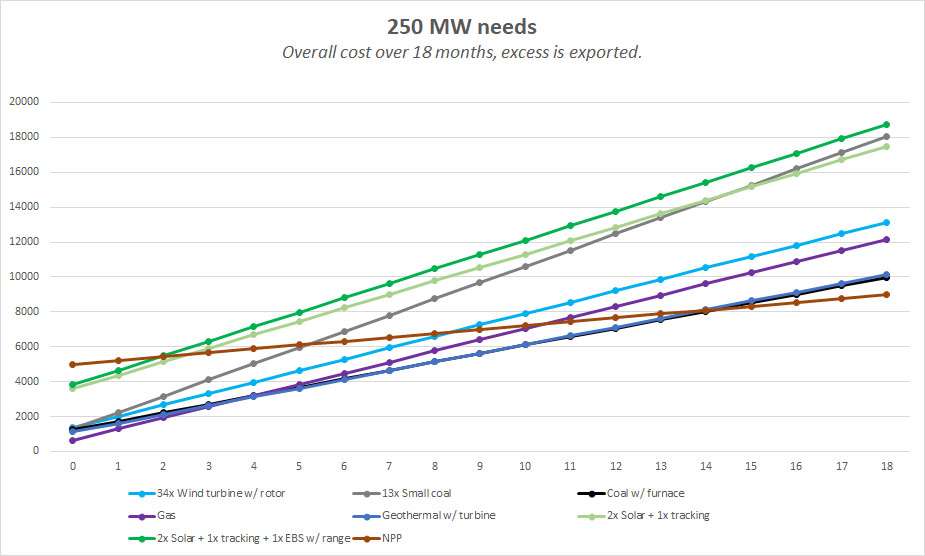



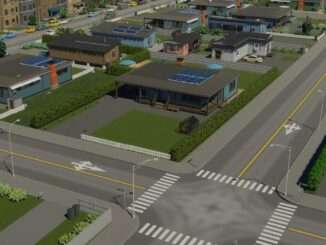
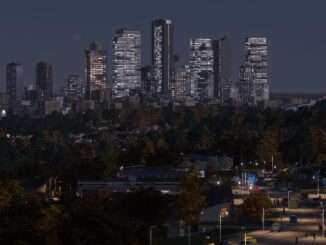

Nice guide, although the education requirement also brings up the cost of of operation.
For instance if you need cims with a university education, then unfortunately you need a university to fill the demand (and all the tiers of education prior to that).
Power stations that require cims also only output their full amount if its fully staffed, so if there isn’t enough educated cims you can end up with less power meaning either brownouts or switching from exporting to importing energy (which can cause you financially to go in the red)
Why does the solar power plant have a higher noise pollution than the geothermal power plant? Why does it have that at all?
And why is geothermal more expensive than nuclear? It doesn’t need any fuel at all.
What the hell devs?
Well in the case of solar it does make sense considering the buzzing they make IRL. A big solar farm produces a significant humming sound that can be disturbing. Perhaps not in the sense you’d imagine but still.
As for the geothermal, i don’t know much about it but the cost is only higher per MW, not overall. Nuclear is so cheap per MW only because it produces a ton of power. However the NPP in CS2 is a relatively modest one considering the Chinon A3 in France reached 480 MW as early as 1966 and 4th gen reactors can reach upwards of 1000 MW. You can scale nuclear up or down but the case of one reactor paid for and managed by a small city is already pretty unrealistic, so i can only assume some of these values are heavily tweaked to make it work in the context of a game.
It’s a game trying to be realistic, so there’s a fine line to be walked before any fun is killed i suppose.